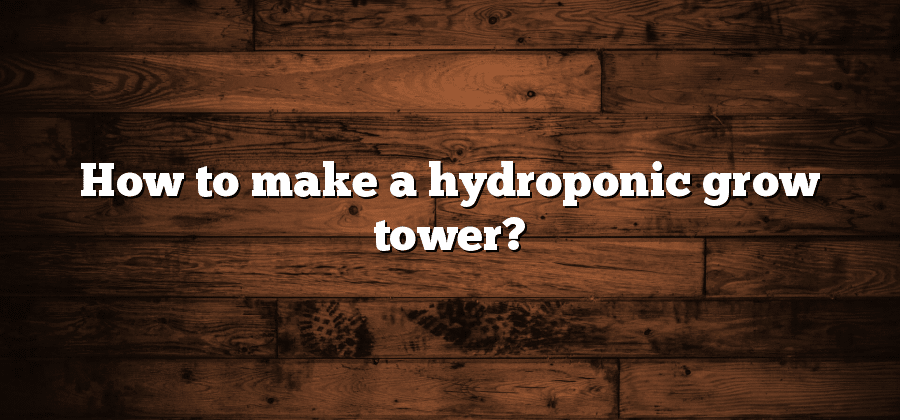Materials Needed for a Hydroponic Grow Tower
To successfully set up a hydroponic grow tower, you need to gather the necessary materials. These materials will ensure that your plants have the right environment to thrive and grow abundantly. The key materials you will need include grow towers, net pots, drip emitters, an air pump, air stones, a water reservoir, a water pump, and a pH testing kit.
Grow towers are the backbone of a hydroponic system, providing the structure for your plants to grow vertically. Net pots are used to hold the plants in place, and drip emitters ensure a steady supply of nutrient-rich water to each plant. An air pump and air stones help oxygenate the water, providing the necessary nutrients for healthy plant growth. The water reservoir and pump work together to circulate the water and deliver it to the plants. Lastly, a pH testing kit is essential for maintaining the optimal pH levels in the water, which is crucial for nutrient absorption.
By gathering these materials, you are setting yourself up for a successful hydroponic gardening experience. With the right tools in hand, you can create a thriving environment for your plants to flourish. In the following sections, we will dive deeper into selecting the right location for your grow tower, preparing the structure, setting up the water reservoir and pump, and choosing the right growing medium. Let’s explore these topics further to ensure you have all the knowledge you need to create a successful hydroponic grow tower.
Selecting the Right Location for Your Grow Tower
Selecting the right location for your grow tower is crucial to the success of your hydroponic system. Before you begin setting up your tower, take some time to evaluate your space and consider a few key factors. First and foremost, your grow tower will require access to ample sunlight or artificial lighting. This is essential for the growth and development of your plants. Choose a spot that receives at least six to eight hours of direct sunlight each day, or ensure that you have a reliable lighting system in place to provide the necessary illumination.
In addition to sunlight, it is important to take into account the temperature and humidity levels of your chosen location. Most plants thrive in a moderate climate with temperatures around 70-80 degrees Fahrenheit and humidity levels between 50-70%. If your space is too hot or too cold, your plants may struggle to grow properly. Similarly, if the humidity is too high or too low, it can lead to issues such as mold or drying out of the plants. To maintain the ideal conditions, consider using a thermometer and hygrometer to monitor the temperature and humidity levels within your selected area. By choosing a location that meets these requirements, you are creating an optimal environment for your plants to flourish. So, let’s move on and explore the next step in preparing your grow tower structure.
Preparing the Grow Tower Structure
When it comes to preparing the grow tower structure for your hydroponic system, there are a few key steps to follow. First and foremost, it is important to choose a sturdy and reliable grow tower structure that can support the weight of the plants and the grow medium. Look for materials such as PVC pipes or metal frames that are durable and can withstand the elements.
Once you have selected the appropriate structure, the next step is to assemble it according to the manufacturer’s instructions. This may involve connecting the pipes or pieces together, securing them with bolts or screws, and ensuring that the structure is stable and level. It is essential to take your time during this process to ensure that the grow tower is properly constructed and will be able to support the weight of the plants as they grow.
Setting Up the Water Reservoir and Pump
When setting up a hydroponic grow tower, one key component that requires careful attention is the water reservoir and pump. This system is essential for supplying the necessary nutrients and water to your plants, ensuring their healthy growth. To successfully set up the water reservoir and pump, there are a few key steps to follow.
First and foremost, you need to select an appropriate water reservoir that can accommodate the number of plants you intend to grow. The reservoir should be made from a non-transparent material to prevent the growth of algae and other unwanted organisms. Additionally, it should have a lid or cover to prevent evaporation and keep debris from entering the water. Depending on the size of your grow tower and the number of plants you plan to cultivate, you may need a reservoir ranging from a few gallons for single-tower setups to larger containers for multiple towers. Now, let’s dive deeper into the process of setting up the water pump and reservoir for a successful hydroponic setup.
Choosing the Right Growing Medium
The choice of growing medium is a critical factor in the success of your hydroponic grow tower. It is important to select a medium that provides good support for the plants, allows for proper drainage, and provides adequate oxygen to the roots. There are several options available, each with its own advantages and disadvantages. Let’s explore some of the most popular choices.
One common option is rockwool, a synthetic material made from melted rock fibers. It is often favored for its ability to hold water while still providing good airflow. This allows the roots to absorb water and nutrients while preventing them from becoming waterlogged. Rockwool is available in various sizes and shapes, making it versatile for different types of plants. However, it is important to note that rockwool requires proper pH and nutrient management, as it can be prone to nutrient imbalances.






